A Guide to Diving With Sharks: Thrills, Chills, and Safety Skills
Diving with sharks – a dream for some, a nightmare for others. The idea of coming face to face with these formidable predators can send chills down your spine, but is it really as risky as it seems?
The truth is, it depends on the shark species and how you approach the encounter. Most sharks are entirely harmless unless deliberately provoked or threatened. This article provides the essential safety skills and guidelines to follow when diving with sharks.
Is it Safe to Dive with Sharks?
Diving with sharks has always been a thrilling adventure, but one that often raises the question: Is it safe? The answer, surprisingly, is that it depends on the shark.
- Most sharks are harmless unless they are deliberately provoked or feel threatened.
- In general, when diving with sharks, it’s essential to stay observant and keep them in your eyesight.
- Never turn your back on them.
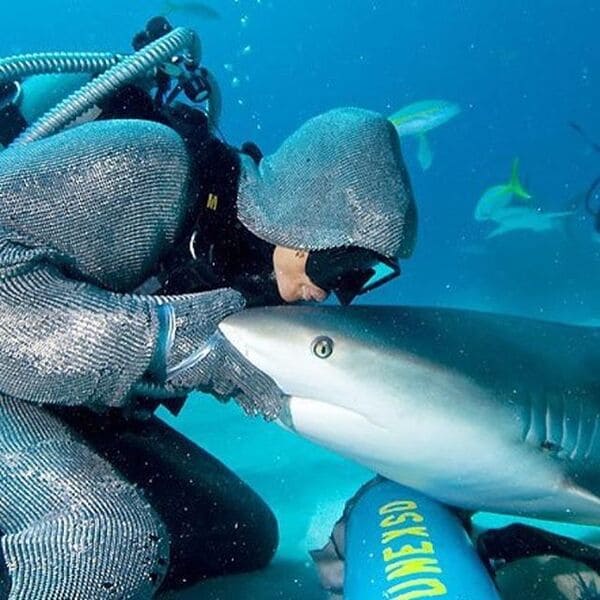
Here are some key safety skills and guidelines to follow when encountering sharks underwater:
1. Be Aware of Territorial Dominance Displays
- Look out for signs of territorial behavior, such as an arched spine, pectoral fins pointed downwards, and erratic, jerky movements.
- If you observe these displays, calmly leave the area without making sudden movements.
2. Handling Larger Sharks
- Larger sharks may exhibit curiosity. Stand your ground and, if necessary, gently push them away by the nose if they come too close.
- Keep your hands and arms close to your body, especially if sharks are feeding or if there are small fish in the vicinity.
3. Maintain Slow and Controlled Movements
- Make slow and controlled movements underwater. Avoid flailing or finning hard, as sudden movements can startle the sharks and provoke defensive reactions.
4. Avoid Approaching or Chasing Sharks
- Move slowly and steadily beneath the surface, and never approach or chase sharks. Approaching them may startle the animals and lead to unwanted interactions.
5. Stay Close to the Reef Wall or Seabed
- Dive close to the reef wall or seabed to avoid leaving yourself exposed. This minimizes the chance of a shark sneaking up behind you, as many sharks are ambush predators.
- Staying near the reef or seabed also helps prevent getting pulled into open water by strong currents.
6. Dive in a Group
- Dive with a group to ensure there are always eyes looking for sharks and monitoring both shark and diver behavior.
- However, avoid diving in overly large groups, as some sharks may perceive a large group as a single, larger threat.
7. Be a Respectful Visitor
- Treat the shark’s environment with respect. Blend into the reef wall or seabed and observe the shark with minimal disturbance.
- Avoid wearing brightly colored wetsuits or jewelry, which may mimic the appearance of brightly colored prey.
- Never “eyeball” the shark or flash your camera in its face, as this can aggravate it.
8. Do Your Homework
- Research the behavior of sharks in your dive environment.
- Read reputable articles specific to the shark species you may encounter.
- Speak with local experts and guides to gain valuable insights into shark behavior.
9. Understand Warning Signals
- Sharks typically move slowly and steadily, conserving energy.
- They are intelligent animals that will display warning signals if they feel threatened by a diver’s presence.
- If a shark suddenly changes behavior, such as dropped pectoral fins, a gaping mouth, an arched back, erratic motions, or increased speed, take it as a warning to move closer to the reef or seabed and potentially abort the dive.
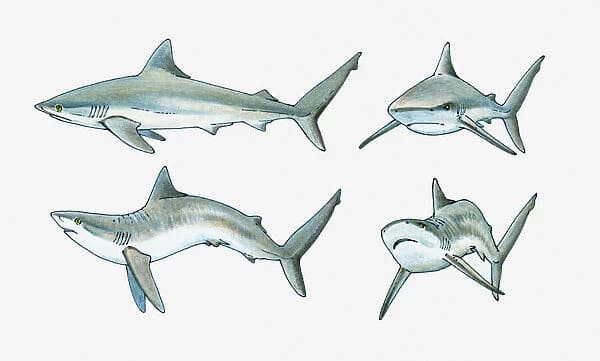
10. Maintain Situational Awareness
- Don’t let your camera distract you from the safety essentials of diving:
- Gas supply
- Bottom time
- Depth
- Your buddy
- Stay close to your buddy and monitor your gas consumption, no-decompression limits, depth, and ascent rate.
- Keep your composure and apply stress resilience in any situation.
Special Note: Some inexperienced or imprudent divemasters and dive guides will attract shark attention by crunching empty plastic bottles in the water. This mimics the noise of sharks feeding and puts sharks into an aggressive state that is a risk to scuba divers. Do not dive with professionals who do this!
Shark Attack Statistics
To put shark attacks into perspective:
- In 2022, there were 108 cases of shark-human interactions worldwide, with only 57 unprovoked attacks.
- Of the 108 incidents, only a few involved individuals participating in snorkeling and diving-related activities.
- Shark attacks on divers represent only 3% of the total number of diving-related fatalities recorded over several decades in Australia.
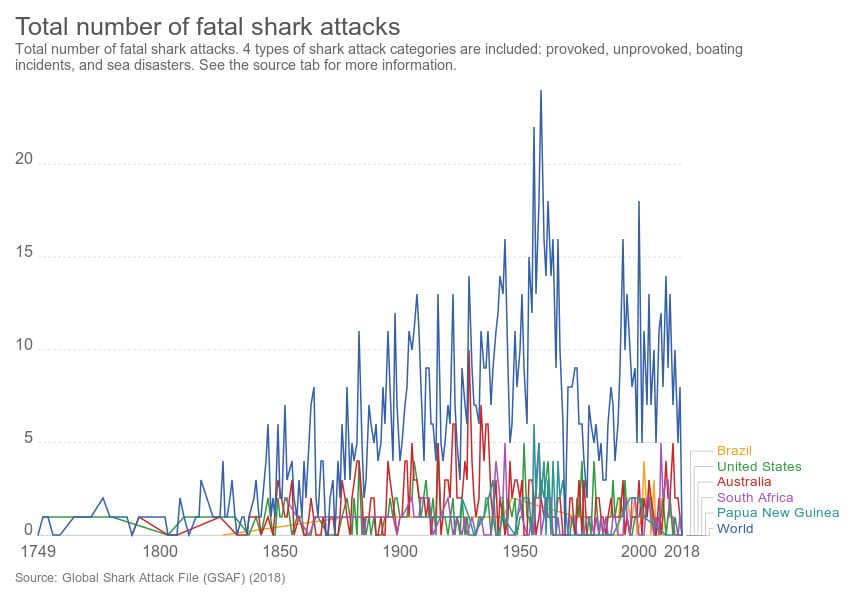
What Causes Shark Attacks?
Sharks, like other predators, may attack for various reasons:
- Mistaken identity: Sharks sometimes mistake humans for prey due to similarities in appearance or behavior.
- Confusion: If humans resemble their regular prey, such as seals, sharks may bite.
- Disturbance: Erratic movements or splashing noises may attract sharks as they mimic wounded marine animals.
- Self-defense: Sharks may attack when they feel provoked or cornered.
- Territorial Protection: Sharks may perceive divers as competition for food. They may attach to defend their feeding ground.
How to Avoid a Shark Attack while Scuba Diving
To minimize the risk of a negative shark encounter while scuba diving:
- In general, stay observant and keep them in eyesight. Don’t turn your back on them.
- Be aware of territorial dominance displays: arched spine, pectoral fins pointed downwards, and erratic, jerky movements. If seen, calmly leave the area.
- Larger sharks may be inquisitive. Stand your ground and, if necessary push them away gently by the nose.
- Keep your hands/arms close to your body, especially if sharks are feeding and/or there are small fish in the vicinity.
- Make your own movements slow and controlled. Don’t flail around or fin hard.
Types of Shark Diving
Natural Encounters
Many sharks, including great whites, oceanic whitetips, and whale sharks, display habitual behavior patterns that can help predict when and where they are most likely to be encountered.
Understanding these patterns is crucial for divers seeking to observe sharks in their natural environment with minimal impact.
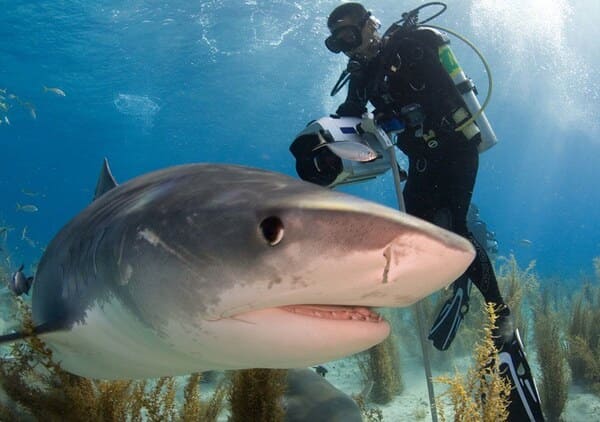
Shark Cage Diving
Shark cage diving is an exhilarating and exciting way to get up close and personal with sharks, particularly great white sharks.
While it offers unforgettable experiences, it’s not without controversy. Participants watch from submerged metal cages as sharks are lured in close using chum.
Cage systems can vary, with some sitting just below the surface and supplying air via a surface feed. This allows non-divers to participate, while others are suspended mid-water or self-propelled.
Despite its popularity, shark cage diving can disrupt shark behavior and their ecosystem due to chumming and baiting, which can alter feeding interactions and migratory patterns. However, it also provides valuable research opportunities and fosters a positive attitude towards these magnificent creatures.
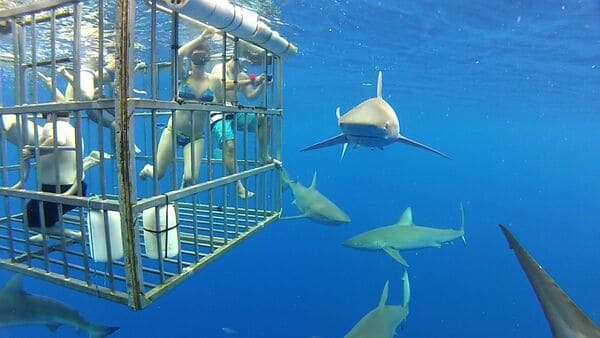
Controlled Feeding Sessions
Some operators encourage shark populations in their local areas by introducing food. This learned behavior ensures that sharks reliably appear for feeding sessions. While this practice can disrupt normal feeding patterns, it allows people to appreciate and understand sharks better.
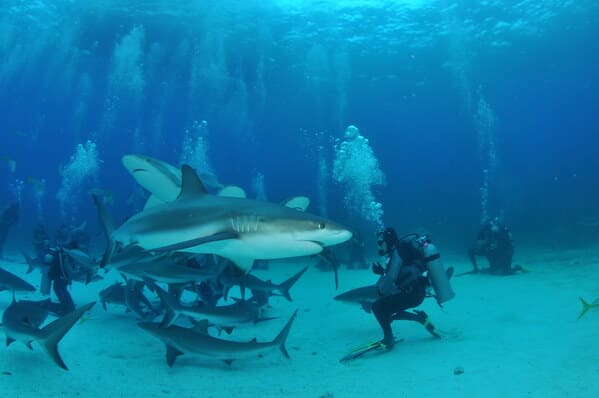
Where To Dive With Sharks
Sharks inhabit oceans across the globe, offering numerous opportunities for thrilling encounters. While there are countless locations to dive with these magnificent creatures, some of the planet’s premier shark diving destinations can be found in Southeast Asia.
Here are some top shark diving locations around the world:
1. Malapascua Island, Philippines
Malapascua Island is a renowned diving destination, famous for its incredible underwater encounters, particularly at the legendary Monad Shoal.
Monad Shoal is an underwater plateau featuring several cleaning stations along its reef edge. Here, you can dive with resident thresher sharks that come in at dawn. As you watch, cleaner wrasse and other fish species diligently clean the sharks’ skin of debris and parasites.
Additionally, other shark species, including hammerhead sharks, make appearances, with March and April being prime months for their sightings.
- Resident thresher sharks at Monad Shoal.
- Cleaner wrasse provides cleaning services to thresher sharks.
- Occasional appearances of hammerhead sharks, especially in March and April.
2. Sipadan, Sabah, Malaysia
Sipadan, Malaysia’s sole oceanic island, offers a unique diving experience. The island’s reef, perched on top of an extinct volcano rising from the Celebes Sea, creates ideal conditions for diverse marine life.
At sites like Barracuda Point, you can encounter whitetip and grey reef sharks cruising off the wall or hunting in shallower waters.
The rich waters also attract blacktip sharks, leopard sharks, hammerhead sharks, and thresher sharks, particularly when upwellings of cold water occur.
Sipadan is home to other remarkable marine species, including green and hawksbill turtles, barracuda, jackfish, and more.
- Whitetip and grey reef sharks at Barracuda Point.
- Diverse shark species, including hammerhead sharks and thresher sharks.
- Abundance of marine life, including turtles, barracuda, and jackfish.
3. Bajo Alcyone – Cocos Island, Costa Rica
Cocos Island, situated far from Costa Rica’s mainland, is consistently ranked among the world’s top destinations for hammerhead shark diving.
Accessible only by liveaboard, this remote location promises multiple world-class dive sites. However, the ultimate shark encounter awaits at Bajo Alcyone, a seamount rising to 82 feet (25 meters).
It attracts seasonal schooling hammerhead sharks (best seen from June to November). Diving to the top of the mount and wedging into a protected area allows you to witness the action unfold all around you.
- Seasonal schooling hammerhead sharks at Bajo Alcyone.
- Rich marine life includes whale sharks, Galapagos sharks, silky sharks, and silvertip sharks.
- Remote location accessible via liveaboard diving trips.
4. Gordon Rocks – Galapagos Islands, Ecuador
The Galapagos Islands, part of the legendary “Shark Triangle” alongside Cocos Island and Malpelo, provide exceptional shark diving opportunities.
Among its many sites, Gordon Rocks near Santa Cruz Island is a shark diving hotspot. Strong currents at Gordon Rocks attract dozens of hammerhead sharks, offering a thrilling experience for divers.
Additionally, you’ll encounter Galapagos sharks, silky sharks, whale sharks, blacktip sharks, and more. Divers can get reasonably close to the sharks but should have prior experience with diving in currents.
- Abundant hammerhead sharks at Gordon Rocks.
- Varied shark species, including Galapagos sharks, silky sharks, and whale sharks.
- Diving in strong currents requires intermediate to advanced experience.
5. Tiger Beach – Grand Bahama Island, Bahamas
The Bahamas is renowned as the world’s premier shark diving destination, with encounters ranging from reef sharks to great hammerheads.
Among the top sites is Tiger Beach, where you’re nearly guaranteed safe encounters with tiger sharks. Divers wait in groups on the sandy bottom as the majestic sharks circle around, providing a unique and exhilarating experience.
You may also spot nurse, lemon, and Caribbean reef sharks during your dives.
- Safe encounters with tiger sharks at Tiger Beach.
- Additional shark species include nurse, lemon, and Caribbean reef sharks.
- Ideal time to visit is from October to January, avoiding the hurricane season.
6. Socorro Islands, Mexico
Socorro Islands, located 240 miles southwest of Cabo San Lucas, offer some of the world’s best shark diving experiences. The islands teem with schooling hammerhead sharks, Galapagos sharks, silky sharks, silvertip sharks, dolphins, whales, manta rays, and other incredible pelagic marine life.
Lucky divers might even witness whale sharks, oceanic whitetips, pilot whales, or humpback whales at sites like Roca Partida.
Socorro is a remote destination, and liveaboard trips departing from Cabo San Lucas are necessary for diving here.
- Abundance of schooling hammerhead sharks.
- Varied marine life, including dolphins, whales, and manta rays.
- Whale shark encounters are possible during a limited season.
The Truth About Shark Diving
Sharks are often portrayed negatively, but they are essential for the balance of marine ecosystems. While shark attacks on humans are rare and can be avoided with proper precautions, human activities pose a more significant threat to sharks.
By understanding their behavior and respecting their environment, divers can safely enjoy the thrill of encountering these magnificent creatures in their natural habitat.
Shark Diving FAQs
The majority of unprovoked shark attacks in 2022 occurred in the United States and Australia, with Florida being a hotspot. The Atlantic Ocean sees more attacks than the Pacific Ocean, likely due to water temperature and human activity.
While there are over 400 shark species, only a few are considered threats to humans. Great white, tiger, and bull sharks are the primary culprits. Attacks are often a result of territorial defense, curiosity, or mistaken identity.
Sharks are often misunderstood. Most attacks occur due to humans invading their territory or resembling prey. Sharks may also attack when provoked, unintentionally harassed, or when they perceive a threat to their food source.
Contrary to popular belief, sharks are not necessarily attracted to menstrual blood. They are more interested in amino acids found in fish blood and marine animal tissues.
Shark cage diving is relatively safe, with no reported fatalities. However, incidents have occurred due to unmet cage diving regulations, especially when baiting is done too close to the cage.
About The Author

Andy Davis is a RAID, PADI TecRec, ANDI, BSAC, and SSI-qualified independent technical diving instructor who specializes in teaching sidemount, trimix, and advanced wreck diving courses.
Currently residing in Subic Bay, Philippines; he has amassed more than 10,000 open-circuit and CCR dives over three decades of challenging diving across the globe.
Andy has published numerous diving magazine articles and designed advanced certification courses for several dive training agencies, He regularly tests and reviews new dive gear for scuba equipment manufacturers. Andy is currently writing a series of advanced diving books and creating a range of tech diving clothing and accessories.
Prior to becoming a professional technical diving educator in 2006, Andy was a commissioned officer in the Royal Air Force and has served in Iraq, Afghanistan, Belize, and Cyprus.
In 2023, Andy was named in the “Who’s Who of Sidemount” list by GUE InDepth Magazine.
Purchase my exclusive diving ebooks!
Originally posted 2023-09-11 12:48:04.














